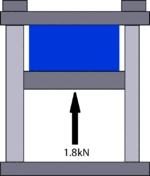Compression set
The compression set (ASTM D395) of a material is the permanent deformation remaining after removal of a force that was applied to it. The term is normally applied to soft materials such as elastomers. Compression is normally measured in two ways: compression set A and compression set B.[1]
Compression Set A

This has the formal name compression set under constant force in air. In compression set A a force of 1.8 kN is applied to the specimen for a set time at a set temperature. Compression set A is defined as the percentage of original specimen thickness after the specimen has been left in normal conditions for 30 minutes. CA, the compression set A is given by CA = [(to - ti) / to] * 100 where to is the original specimen thickness and ti is the specimen thickness after testing.[1]
Compression Set B

This has the formal name compression set under constant deflection in air. The specimen is compressed to 75% of its original height for a set time and at a set temperature (sample is compressed to .75 of its original height) Compression set B is (like Compression set A) defined as the percentage of original specimen thickness after it has been left in normal conditions for 30 minutes. CB, the compression set B is given by CB = [(to - ti) / (to - tn)] * 100 where to is the original specimen thickness, ti is the specimen thickness after testing and tn is the spacer thickness or the specimen thickness during the test.[1]
References
- "Compression Set - ASTM D395 Plastic Test Standard". IDES. Integrated Design Engineering Systems. Archived from the original on 28 December 2011. Retrieved 15 June 2012.